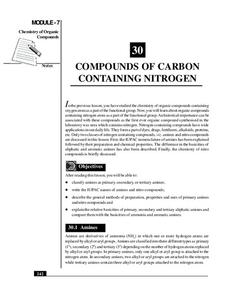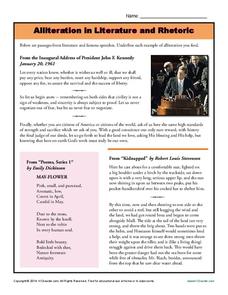Curated OER
A Whiff of Danger
Public health trainees read and write a summary of the article, "A Whiff of Danger". The article is not available through the link, but can be found on the National Center for Biotechnology Information website. After summarizing,...
Curated OER
East Timor: The World's Newest Country
This isn't just a hand-out or a reading passage; it's more like a mini book on the history, colonization, independence, and culture of the South East Asian country of Timor. There are extensive readings and discussion questions for...
National Institute of Open Schooling
Compounds of Carbon Containing Nitrogen
Amines are vital to humans because they help form amino acids, the building blocks of proteins. The 30th lesson in a series of 36 specifically focuses on the organic compounds that contain nitrogen. Learners classify amines and nitro...
National Institute of Open Schooling
Compounds of Carbon Containing Halogens (Haloalkanes and Haloarenes)
Halogens comes from a Greek word which translates to make salt. Lesson 27 in the series of 36 teaches pupils about halogens. Pupils read, discuss, and answer questions in order to learn about haloalkanes and haloarenes. From defining...
Curated OER
The Stolen Smell
Third graders read the story The Stolen Smell, and complete language arts activities based on the book. In this The Stolen Smell lesson plan, 3rd graders complete activities such as discussion, reading, researching, drawing, role...
Curated OER
Choir Singer says.../o/
Students develop aromaticity of recognizing letters. They recognize short o, /o/, in written and spoken words. Students read a story and discuss the shape their mouths make when saying the short o sound. They identify words with the...
K12 Reader
Alliteration in Literature and Rhetoric
Middle schoolers are asked to identify the alliteration used in John F. Kennedy's Inaugural Address, Emily Dickinson's "May-Flower," and a passage from Robert Lewis Stevenson's Kidnapped.
Curated OER
Don't Say "Said," Say . . .
In this word choice worksheet, students read the various alternatives for the word 'said.' Students then brainstorm alternatives for another over-used word.
K12 Reader
Synonyms or Antonyms?
To demonstrate their understanding of synonyms and antonyms, kids label pairs of words as either the same or opposite in meaning.
National Institute of Open Schooling
Hydrocarbons
The vast majority of hydrocarbons humans use help fuel cars, homes, and provide energy. A comprehensive lesson teaches pupils all about hydrocarbons. From alkanes, alkenes, and alkynes to benzene, classes study the preparation of these...
Royal Society of Chemistry
Organic Molecules Day—Chemistry Outreach
In search of an organic lab that employs real-life techniques and analysis methods? Groups carry out the nitration of methyl benzoate, then attempt to determine the number and location of the nitro groups added to the benzene ring....
Curated OER
Preserving Buds and Blooms
Students learn how to preserve flower buds and blooms. In this gardening activity, students explore the methods of air drying, using drying agents, and pressing plants to preserve them.
Curated OER
Honey Bee Communication
Students participate in a role play to show how honey bees communicate with one another. In this honey bee lesson, students learn that honey bees communicate with dance. Students create the honey bee environment and role play the dances...














